
Antioxidant and Anti-inflammatory Activities of Rumex acetosa
Abstract
Rumex acetosa is a folk medicine for gastritis and gastric ulcers. In our previous study, the ethanol extract of R. acetosa inhibited gastric ulcers and protected gastric tissue in mice induced with HCl/ethanol from gastric ulcers. Moreover, we isolated six anthraquinone compounds from this plant and evaluated their anti-Helicobacter pylori activity. Therefore, this study was conducted to identify further the related antioxidant and anti-inflammatory activities and the bioactive constituents. Five fractions of n-hexane, methylene chloride, ethyl acetate, n-butanol, and aqueous fractions were obtained from the total ethanolic extract from whole parts of R. acetosa that had exhibited antioxidant and anti-inflammatory activities. The ethyl acetate fraction contained the highest total phenol and flavonoid contents among the five fractions and exhibited the most potent antioxidant effect on 2,2-diphenyl-1-picrylhydrazyl radical scavenging assay. Among the six compounds, emodin showed the most potent antioxidant activity. Next, we induced inflammation in the LPS-induced RAW 264.7 cell line. The methylene chloride fraction showed the strongest reducing nitric oxide production activity among the fractions. In addition, the methylene chloride fraction suppressed the phosphorylation of ERK and JNK, and the expression of cyclooxygenase-2 in a dose-dependent manner. These physiological activities of the fraction and the compounds could be involved in the anti-gastric ulcer activity of R. acetosa.
Keywords:
Rumex acetosa, antioxidant activity, anti-inflammatory activity, anthraquinonesIntroduction
Oxidative stress is a significant contributor to the development of chronic inflammatory conditions. Reactive oxygen species (ROS) has a vital role in gastric ulceration induced by various types of stress in gastric lesions.1,2 Moreover, free radicals and their derivatives activate nuclear factors such as NF-κB, producing various cytokines associated with inflammatory responses. These, in turn, exacerbate inflammation and trigger the generation of other reactive species.3
Inflammation is a natural defense mechanism against allergy, injury, and infection.4 When an inflammatory response occurs, various inflammatory mediators such as tumor necrosis factor-α (TNF-α), cyclooxygenase-2 (COX-2), and nitric oxide (NO) are expressed.5 Chronic inflammation can lead to various pathological conditions, including cancer, lupus, fibromyalgia, and rheumatoid arthritis.6 Steroids and non-steroidal anti-inflammatory drugs (NSAIDs) are therapeutic agents to prevent excessive inflammatory responses. Still, these medications have side effects such as heartburn, abdominal pain, ulcers, headaches, and fatigue.7 As a result, searching for effective anti-inflammatory agents from natural resources with fewer side effects has gained significant attention in medical research.
Rumex acetosa L., known as sorrel, is a herbaceous perennial plant widely distributed in Japan, China, and Korea.8,9 R. acetosa is rich in bioactive compounds, including anthraquinones10 and flavonoids.11,12 These phytochemicals are known for their antioxidant activities and have been linked to various health benefits.13 This plant has been used as a folk medicine for gastritis and gastric ulcers.14 Furthermore, the biological activities have been reported to include antitumor,15,16 and antiviral properties.17 In our previous study, ethanol extract of R. acetosa protected more potently gastric tissue in mice induced with HCl/ethanol from gastric ulcer than water extract.14 The ethanol extract also exhibited antioxidant and anti-inflammatory activities. Additionally, six anthraquinone compounds were isolated from R. acetosa, and their inhibitory activity against H. pylori was revealed.18 Therefore, in this study, we aimed to identify further the related antioxidant and anti-inflammatory activities of R. acetosa fractions and the bioactive compounds.
Experimental
Plant materials – The dried whole parts of Rumex acetosa L. were purchased from an oriental market in Sancheong province, Korea, in April 2014. The plant was identified by Dr. Mi-Jeong Ahn, College of Pharmacy, Gyeongsang National University. The voucher specimen (No. PGSC-172–177) was deposited in the Herbarium of the College of Pharmacy, Gyeongsang National University.
Extraction and fractionation - The preparation of total ethanol extract and fractions from the dried sample was performed according to the procedure in our previous study.18 The fractions were n-hexane, methylene chloride (CH2Cl2), ethyl acetate (EtOAc), n-butanol, and water fractions.
Antioxidant activity - Total phenolic and flavonoid contents and 2,2-diphenyl-1-picrylhydrazyl (DPPH) radical scavenging activity were measured by our previously reported methods.19,20 The antioxidant activity was expressed as trolox (Sigma-Aldrich, Saint Louis, MO, USA) equivalents per gram (μmol TE/g).
Cell culture - RAW 264.7 cell line was provided by the Korea Cell Line Bank (Seoul, Korea).21 The cell line was grown and maintained under 100% humidity and 5% CO2 for 2–3 days at 37oC. Dulbecco’s modified eagle medium (DMEM) supplemented with 10% fetal bovine serum and 1% penicillin/streptomycin was used.
Cell viability - Cell viability was assessed by MTT assay.21 The cells were seeded in 96 wells at a density of 1 × 105 cells/well, incubated for 24 h, and treated with 12.5–100 μg/mL concentrations of samples for 24 h. Each well was treated with the MTT solution, and the absorbance was measured at 570 nm and used by a microplate reader (Perkin Elmer, Victor X5, Waltham, MA, USA).
The measurement of NO production - The NO production was measured by our previously reported method.21 The cells were seeded in 96 wells at a density of 1 × 105 cells/well, incubated for 24 h, pretreated with 12.5–100 μg/mL concentrations of samples for 3 h, and stimulated with lipopolysaccharide (10 μg/mL) for 21 h. The measurement of NO productions was used by supernatant with Griess reagent (Sigma-Aldrich) for 10 min, and the absorbance was measured at 540 nm.
Western blot analysis - Western blot analysis was followed by previously reported method with a slight modification.22 Briefly, the RAW 264.7 cell line treated with LPS or sample was then scraped using a cell scraper and lysed in lysis buffer. Protein was taken for separation using sodium dodecyl sulfate-polyacrylamide gel electrophoresis (SDS-PAGE). The separated proteins were transferred to a PVDF membrane. To block non-specific binding, the membrane was incubated with blocking buffer (TBST containing 5% non-fat milk and 0.1% Tween-20) and then reacted with primary antibodies (ERK, p-ERK, JNK, p-JNK, p38, p-p38, COX-2 and β-actin; 1:1000 dilution) (Cell Signaling Technology, MA, USA) overnight to assess the expression levels. After washing with TBST solution, the membrane was incubated with a secondary antibody (ERK, p-ERK, JNK, p-JNK, P38, p-P38, COX-2 and β-actin; 1:5000 dilution) (Cell Signaling Technology, MA, USA) for 1 hour. The bands were visualized using an ECL solution.
Statistical analysis - All values were expressed as means ± standard deviations (SD). The statistical differences among the samples by one-way analysis of variance (ANOVA) using Excel (Microsoft, Redmond, WA, USA). Values with *p < 0.05, **p < 0.01, ***p < 0.001 were considered statistically significant.
Results and Discussion
R. acetosa has been used as a folk medicine to treat abdominal pain and gastrointestinal disorders. Our previous report confirmed that the R. acetosa extract suppresses HCl/ethanol-induced gastric ulcers and exhibits excellent gastrointestinal protective activity. It exhibited DPPH radical scavenging activity and inhibitory activity on NO production in the LPS-induced RAW 264.7 cell line.14 Three anthraquinones of emodin (1), chrysophanol (2), and physcion (3), were major compounds in the methylene chloride fraction, and three anthraquinone glucosides of emodin-8-O-β-D-glucoside (4), chrysophanol-8-O-β-D-glucoside (5), and physcion-8-O-β-D-glucoside (6) were major compounds in the ethyl acetate fraction (Fig. 1).18 These compounds showed significant anti-Helicobacter pylori activity. H. pylori is known to be involved in gastrointestinal disorders.18 In this study, we evaluated the antioxidant and anti-inflammatory activities of the fractions and elucidated the responsible compounds
The total ethanol extracts of R. acetosa showed DPPH radical scavenging activities with the mean value of 322.4 ± 6.9 μmol TE (trolox equivalence)/g. The EtOAc fraction showed the highest DPPH radical scavenging activity (1093.6 ± 31.8 μmol TE/g) among the five fractions (Fig. 2A). The DPPH radical scavenging activity of CH2Cl2 and n-butanol fractions ranked the second group, and the mean values were 442.1 ± 0.1 and 660.3 ± 9.5 μmol TE/g, respectively. Among the isolated compounds, emodin showed the strongest antioxidant activity (Fig. 2B). The potent antioxidant activity of emodin, chrysophanol, and physcion has been reported previously.23,24 Three anthraquinone glucosides (4–6) also showed moderate antioxidant activity.25 Generally, phenolic compounds offer antioxidant activity by abstracting highly reactive free electrons from free radicals.26 These electrons are then dispersed within the hydroxy group and the aromatic ring of the antioxidant.26 Emodin has two hydroxy groups, while chrysophanol and physcion have one hydroxy group, respectively. Emodin with more hydroxy groups would exhibit more potent antioxidant activity as they react more readily. Compounds 4–6 have a glucose moiety, and this moiety seems to lower the activity than those of their aglycones.
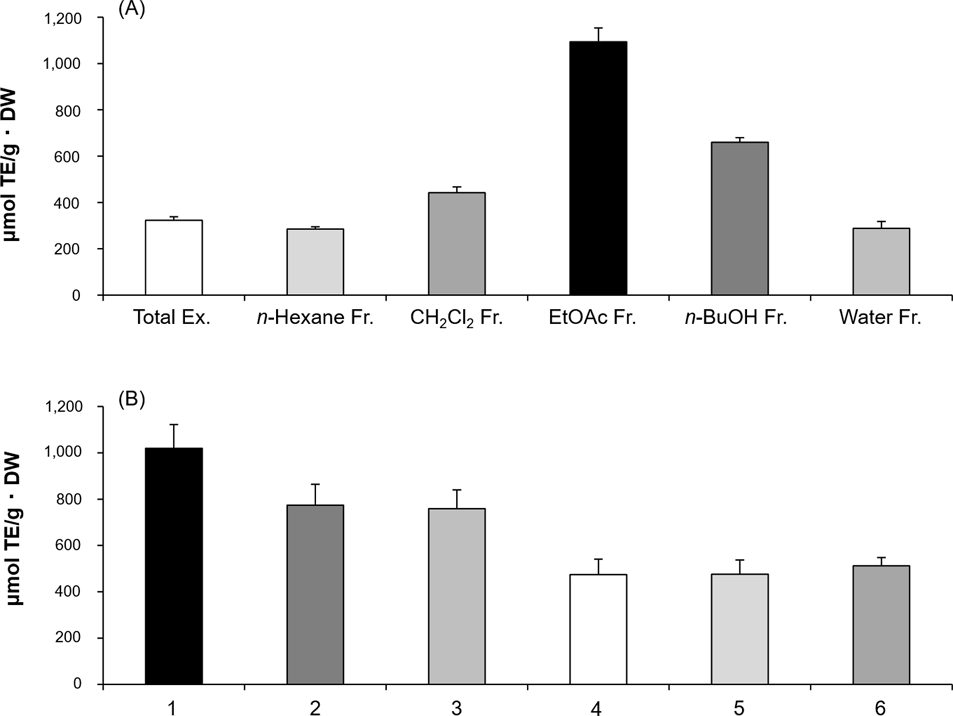
Antioxidant activities of total extract and fractions (A) and compounds 1-6 (B) from R. acetosa on DPPH assay.
The total phenolic content of R. acetosa extract was 438.0 ± 3.6 μmol GAE (gallic acid equivalence)/g. While the EtOAc fraction showed the highest total phenolic content of 1455.8 ± 19.0 μmol GAE/g among the fractions. The n-hexane and water fractions showed the lower total phenolic content compared to other samples (Fig. 3A). The total flavonoid content of CH2Cl2, EtOAc, and n-butanol fractions were almost similar each other with the mean values of 1.2 ± 0.2, 1.2 ± 0.2 and 1.2 ± 0.1 μmol QE (quercetin equivalence)/g, respectively (Fig. 3A). Therefore, the high phenolic content in the EtOAc fraction supports the previously observed high DPPH radical scavenging activity of this fraction.
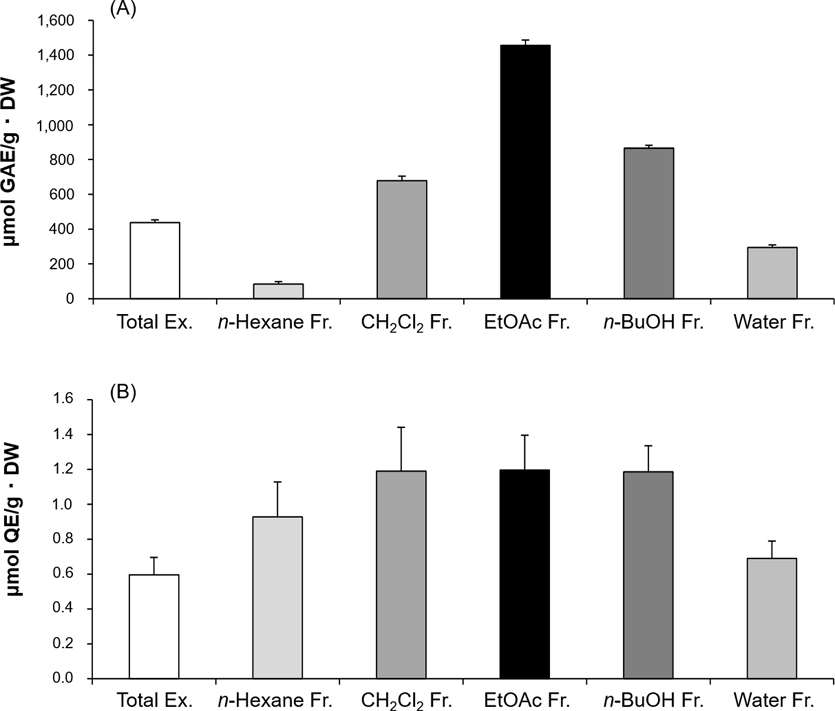
Total phenol (A) and total flavonoid (B) contents of total extract and fractions.GAE, gallic acid equivalent; QE, quercetin equivalent.
Next, we induced inflammation in the LPS-induced RAW 264.7 cell line and measured the inhibition of NO production. All fractions showed no cytotoxicity by a concentration of 50 μg/mL and were used in the experiment at 12.5 – 50 μg/mL (Fig. 4A). The methylene chloride fraction exhibited the most potent inhibitory activity against NO production among the fractions (Fig. 4B). The other two samples of n-hexane and n-butanol fractions exhibited weak inhibitory activity. Based on these findings, we conducted experiments to assess the effect of the extract and fractions on the phosphorylation of mitogen-activated protein kinases (MAPKs). MAPKs, such as ERK, JNK, and p38, are signal transduction proteins activated by external stimuli to transmit signals within the cell.27 When phosphorylated by MAP kinases, they become active forms known as p-ERK, p-JNK, and p-p38. These phosphorylated MAPKs induce the expression of enzymes that promote inflammation and activate cytokines like TNF-α.28 Specifically, the methylene chloride fraction showed the most potent inhibitory activity against the phosphorylation of ERK and JNK (Fig. 5). The n-hexane fraction also inhibited the phosphorylation of ERK. This result suggests that R. acetosa extract and fractions may modulate the inflammatory process by interfering with the activation of MAPK, providing insights into their anti-inflammatory mechanisms. Moreover, methylene chloride fraction inhibited the expression of COX-2 in a dose-dependent manner (Fig. 6). According to previous reports, emodin and emodin-8-O-β-D-glucoside suppress NO production at LPS-induced RAW 264.7 cell.29,30 A main secondary metabolite of the CH2Cl2 fraction, emodin, inhibits receptor expression and common inflammatory pathways, such as NF-κB activation and TNF-α production. It also reduces neutrophil infiltration and cytokine production.31 Another major compound of this fraction, chrysophanol, suppresses the production of TNF-α, interleukin-6, and the expression of COX-2 levels induced by LPS by inhibiting the activation of NF-κB and caspase-1 in LPS-stimulated macrophages.32 The third major constituent, physcion, appears to reduce the synthesis of NO and prostaglandin E2 by suppressing iNOS (inducible nitric oxide synthase) and COX-2 expression.30 Additionally, it inhibits TNF-α secretion by suppressing of MAPKs and NF-κB activation.33 These three anthraquinones may be involved in the anti-inflammation activity of this fraction. Meanwhile, an anthraquinone glycoside physcion-8-O-β-D-glucoside inhibits the TGF-β (transforming growth factor-β)/NF-κB/MAPK pathways, suppressing pro-inflammatory cytokines and mediators in collagen-induced arthritis rats.34
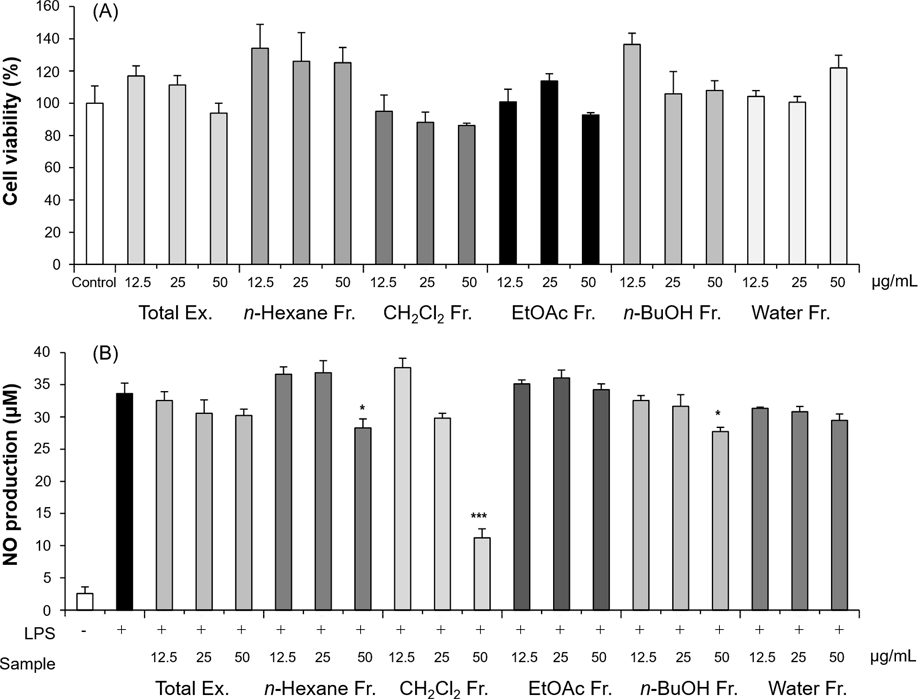
Cell viability (A) and NO production (B) of total extract and fractions from R. acetosa.*Significant at p < 0.05. ***Significant at p < 0.001.
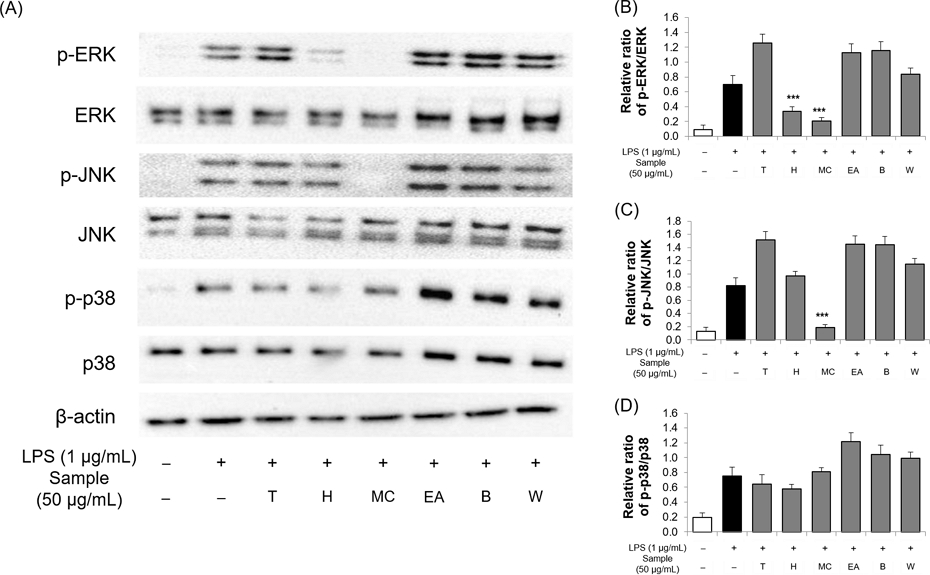
Effect of total extract and fractions from R. acetosa on MAP kinase phosphorylation in LPS-induced RAW 264.7 cell line by western blotting (A). Bar graphs represent the relative phosphorylation of the ERK (B), JNK (C), and p38 MAPK (D) proteins adjusted to the β-actin protein level.T, total extract; H, n-hexane fraction; MC, methylene chloride fraction; EA, ethyl acetate fraction; B, n-butanol fraction; W, water fraction. ***Significant at p < 0.001.
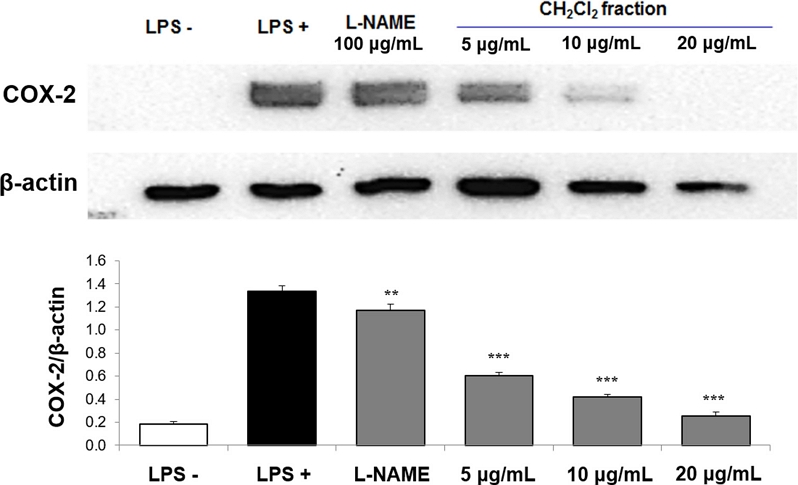
Effect of methylene chloride fraction on LPS-stimulated RAW 264.7 cells.L-NAME: Nω-Nitro-L-arginine. **Significant at p < 0.01. ***Significant at p < 0.001.
Our present results imply that the methylene chloride fraction containing three anthraquinones showed potent anti-inflammatory activity by suppressing the phosphorylation of JNK and ERK. The six major compounds showed significant antioxidant activity, and the ethyl acetate fraction with the highest phenolic content showed the most potent DPPH radical scavenging activity. The present study suggests that the extract, fractions, and their compounds of R. acetosa may be natural candidates for treating oxidative stress and inflammation. However, further studies are needed to evaluate human safety issues and to elucidate the exact mechanism of activity.
Acknowledgments
This research was financially supported by Basic Science Research Program through the National Research Foundation of Korea (NRF) funded by the Ministry of Education (No. 2021R1I1A4A0105729511).
Conflicts of Interest
The authors declare that they have no conflicts of interest.
References
-
Bandyopadhyay, D.; Chattopadhyay, A. Curr. Med. Chem. 2006 , 13, 1187-1202.
[https://doi.org/10.2174/092986706776360842]

-
Hussain, T.; Tan, B.; Yin, Y.; Blachier, F.; Tossou, M. C. B.; Rahu, N. Oxid. Med. Cell. Longev. 2016 , 2016, 7432797.
[https://doi.org/10.1155/2016/7432797]

-
Federico, A.; Morgillo, F.; Tuccillo, C.; Ciardiello, F.; Loguercio, C. Int. J. Cancer 2007 , 121, 2381-2386.
[https://doi.org/10.1002/ijc.23192]

-
Isailovic, N.; Daigo, K.; Mantovani, A.; Selmi, C. J. Autoimmun. 2015 , 60, 1-11.
[https://doi.org/10.1016/j.jaut.2015.04.006]

-
Somasundaram, V.; Gilmore, A. C.; Basudhar, D.; Palmieri, E. M.; Scheiblin, D. A.; Heinz, W. F.; Cheng, R. Y.; Ridnour, L. A.; Altan-Bonnet, G.; Lockett, S. J.; McVicar, D. W.; Wink, D. A. Redox Biol. 2020 , 28, 101354.
[https://doi.org/10.1016/j.redox.2019.101354]

-
Lee, T. H.; Kwak, H. B.; Kim, H. H.; Lee, Z. H.; Chung, D. K.; Baek, N. I.; Kim, J. Mol. Cells 2007 , 23, 398-404.
[https://doi.org/10.1016/S1016-8478(23)10731-X]

-
Wang, Y. H.; Zeng, K. W. Tradit. Med. Res 2019 , 4, 257-268.
[https://doi.org/10.53388/TMR20190831133]

-
Elzaawely, A. A.; Xuan, T. D.; Tawata, S. Biol. Pharm. Bull. 2005 , 28, 2225-2230.
[https://doi.org/10.1248/bpb.28.2225]

-
Vasas, A.; Orbán-Gyapai, O.; Hohmann, J. J. Ethnopharmacol. 2015 , 175, 198-228.
[https://doi.org/10.1016/j.jep.2015.09.001]

-
Lee, N.-J.; Choi, J.-H.; Koo, B.-S.; Ryu, S.-Y.; Han, Y.-H.; Lee, S.-I.; Lee, D.-U. Biol. Pharm. Bull. 2005 , 28, 2158-2161.
[https://doi.org/10.1248/bpb.28.2158]

-
Stöggl, W. M.; Huck, C. W.; Bonn, G. K. J. Sep. Sci. 2004 , 27, 524-528.
[https://doi.org/10.1002/jssc.200301694]

-
Bicker, J.; Petereit, F.; Hensel, A. Fitoterapia 2009 , 80, 483-495.
[https://doi.org/10.1016/j.fitote.2009.08.015]

-
Zhang, X.; Thuong, P. T.; Jin, W.; Su, N. D.; Sok, D. E.; Bae, K.; Kang, S. S. Arch. Pharm. Res. 2005 , 28, 22-27.
[https://doi.org/10.1007/BF02975130]

-
Bae, J. Y.; Lee, Y. S.; Han, S. Y.; Jeong, E. J.; Lee, M. K.; Kong, J. Y.; Lee, D. H.; Cho, K. J.; Lee, H. S.; Ahn, M. J. Biomol. Ther (Seoul). 2012 , 20, 425-430.
[https://doi.org/10.4062/biomolther.2012.20.4.425]

-
Lajter, I.; Zupkó, I.; Molnár, J.; Jakab, G.; Balogh, L.; Vasas, A.; Hohmann, J. Phytother. Res. 2013 , 27, 77-85.
[https://doi.org/10.1002/ptr.4690]

-
Ito, H. Jpn. J. Pharmacol. 1986 , 40, 435-443.
[https://doi.org/10.1254/jjp.40.435]

-
Gescher, K.; Hensel, A.; Hafezi, W.; Derksen, A.; Kühn, J. Antiviral Res. 2011 , 89, 9-18.
[https://doi.org/10.1016/j.antiviral.2010.10.007]

-
Kang, D. M.; Khalil, A. A. K.; Park, W. S.; Kim, H. J.; Akter, K. M.; Bae, J. Y.; Mehtap Büyüker, S.; Kim, J. H.; Kang, K. K.; Ahn, M. J. ACS Omega 2023 , 8, 42548-42554.
[https://doi.org/10.1021/acsomega.3c05282]

-
Kang, D. M.; Kwon, J. M.; Jeong, W. J.; Jung, Y. J.; Kang, K. K.; Ahn, M. J. Molecules 2022 , 27, 8741.
[https://doi.org/10.3390/molecules27248741]

-
Yoon, K. D; Kang, S. N.; Bae, J. Y.; Lee, H. S.; Kwak, S. S.; Jang, I.; Kim, I. S.; Lee, C. H.; Bae, J. M.; Lee, S. W.; Ahn, M. J. Curr. Drug Targets 2013 , 14, 999-1005.
[https://doi.org/10.2174/1389450111314090008]

- Kang, D. M.; Park, W. S.; Kim, H. J.; Jeong, W. J.; Kang, K. K.; Ahn. M. J. Kor. J. Pharmacogn. 2022 , 53, 8-15.
-
Jeong, Y. H.; Oh, Y. C.; Cho, W. K.; Lee, B.; Ma, J. Y. Molecules 2016 , 21, 818.
[https://doi.org/10.3390/molecules21060818]

-
Mellado, M.; Madrid, A.; PeñA-CortéS, H.; LóPez, R.; Jara, C.; Espinoza, L. J. Chil. Chem. Soc. 2013 , 58, 1767-1770.
[https://doi.org/10.4067/S0717-97072013000200028]

-
Shi, D. H.; Huang, W.; Li, C.; Wang, L. T.; Wang, S. F. Bioorg. Med. Chem. 2013 , 21, 1064-1073.
[https://doi.org/10.1016/j.bmc.2013.01.015]

-
Mishra, S. K.; Tiwari, S.; Shrivastava, A.; Srivastava, S.; Boudh, G. K.; Chourasia, S. K.; Chaturvedi, U.; Mir, S. S.; Saxena, A. K.; Bhatia, G.; Lakshmi, V. J. Nat. Med. 2014 , 68, 363-371.
[https://doi.org/10.1007/s11418-013-0810-z]

-
Friedman, M. J. Agric. Food Chem. 1997 , 45, 1523-1540.
[https://doi.org/10.1021/jf960900s]

-
Wang, M. J.; Jeng, K. C. G.; Kuo, J. S.; Chen, H. L.; Huang, H. Y.; Chen, W. F.; Lin, S. Z. J. Neuroimmunol. 2004 , 146, 50-62.
[https://doi.org/10.1016/j.jneuroim.2003.10.034]

-
Song, Y.; Qu, R.; Zhu, S.; Zhang, R.; Ma, S. Phytother. Res. 2012 , 26, 1528-1533.
[https://doi.org/10.1002/ptr.4614]

- Joo, S. M.; Yang, K. S. Yakhak Hoeji 2010 , 54, 387-391.
-
Ghosh, S.; Das Sarma, M.; Patra, A.; Hazra, B. J. Pharm. Pharmacol. 2010 , 62, 1158-1166.
[https://doi.org/10.1111/j.2042-7158.2010.01151.x]

-
Monisha, B. A.; Kumar, N.; Tiku, A. B. Anti-inflammatory Nutraceuticals and Chronic Diseases; Springer: Germany, 2016 , pp 47-73.
[https://doi.org/10.1007/978-3-319-41334-1_3]

-
Kim, S.-J.; Kim, M.-C.; Lee, B.-J.; Park, D.-H.; Hong, S.-H.; Um, J.-Y. Molecules 2010 , 15, 6436-6451.
[https://doi.org/10.3390/molecules15096436]

-
Lee, G.; Choi, T. W.; Kim, C.; Nam, D.; Lee, S. G.; Jang, H. J.; Lee, J. H.; Um, J. Y.; Jung, S. H.; Shim, B. S.; Ahn, K. S.; Ahn, K. S. Immunopharm. Immunot. 2012 , 34, 454-464.
[https://doi.org/10.3109/08923973.2011.619195]

- Geng, Q.; Wei, Q.; Wang, S.; Qi, H.; Zhu, Q.; Liu, X.; Shi, X.; Wen, S. Int. J. Mol. Med. 2018 , 42, 745-754.
